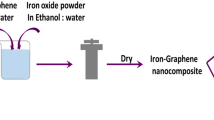Abstract
Graphene oxide (GO) was functionalized to form hydrophobic-reduced graphene oxide (rGO) by a one-step hydrothermal method, and oleylamine was used as both reductant and modifier of GO. X-ray photoelectron spectroscopy, Fourier transform infrared spectroscopy, X-ray diffraction, Raman spectroscopy, and contact angle measurement were used to determine the successful functionalization and reduction of GO. Results indicated that the color of obtained sample was changed from yellow brown to black, and contact angle between water and the graphene paper was over 130°, which was close to the typical hydrophobic material of PTFE; at the same time, the functionalized rGO can be dispersed in some of the typical organic solvents, such as cyclohexane, chloroform, and benzene, proving that oleylamine was effective for the reduction and functionalization of GO. Based on the results, the possible reactions were proposed. Furthermore, the hydrophobic rGO was assembled to film by filtration, which demonstrated its efficient separation ability for oil/water.






Similar content being viewed by others
References
Zhou Y, Bao Q, Tang LAL et al (2009) Hydrothermal dehydration for the “green” reduction of exfoliated graphene oxide to graphene and demonstration of tunable optical limiting properties. Chem Mater 21:2950–2956
Xu Y, Shi G (2011) Assembly of chemically modified graphene: methods and applications. J Mater Chem 21:3311–3323
Zhu Y, Murali S, Cai W et al (2010) Graphene and graphene oxide: synthesis, properties, and applications. Adv Mater 22:3906–3924
Bonaccorso F, Colombo L, Yu G et al (2015) Graphene, related two-dimensional crystals, and hybrid systems for energy conversion and storage. Science 347:1246501
Shao Y, El-Kady MF, Wang LJ et al (2015) Graphene-based materials for flexible supercapacitors. Chem Soc Rev 44:3639–3665
Felten A, Flavel BS, Britnell L et al (2013) Single and double sided chemical functionalization of bilayer graphene. Small 9:631–639
Bai H, Li C, Shi G (2011) Functional composite materials based on chemically converted graphene. Adv Mater 23:1089–1115
Wojtaszek M, Tombros N, Caretta A et al (2011) A road to hydrogenating graphene by a reactive ion etching plasma. J Appl Phys 110:063715
Sarkar S, Zhang H, Huang JW et al (2013) Organometallic hexahapto functionalization of single layer graphene as a route to high mobility graphene devices. Adv Mater 25:1131–1136
Wei W, Qu X (2012) Extraordinary physical properties of functionalized graphene. Small 8:2138–2151
Li D, Mueller MB, Gilje S et al (2008) Processable aqueous dispersions of graphene nanosheets. Nat Nanotechnol 3:101–105
Ciesielski A, Samorì P (2014) Graphene via sonication assisted liquid-phase exfoliation. Chem Soc Rev 43:381–398
Wang Z, Zhou X, Zhang J et al (2009) Direct electrochemical reduction of single-layer graphene oxide and subsequent functionalization with glucose oxidase. J Phys Chem 113:14071–14075
Wen B, Cao M, Lu M et al (2014) Reduced graphene oxides: light-weight and high-efficiency electromagnetic interference shielding at elevated temperatures. Adv Mater 26:3484–3489
Ahn BK, Sung J, Li Y et al (2012) Synthesis and characterization of amphiphilic reduced graphene oxide with epoxidized methyl oleate. Adv Mater 24:2123–2129
Pham TA, Kumar NA, Jeong YT (2010) Covalent functionalization of graphene oxide with polyglycerol and their use as templates for anchoring magnetic nanoparticles. Synth Met 160:2028–2036
Shen J, Hu Y, Li C et al (2009) Synthesis of amphiphilic graphene nanoplatelets. Small 5:82–85
Marcano DC, Kosynkin DV, Berlin JM et al (2010) Improved synthesis of graphene oxide. ACS Nano 4:4806–4814
Wang G, Wang B, Park J et al (2009) Synthesis of enhanced hydrophilic and hydrophobic graphene oxide nanosheets by a solvothermal method. Carbon 47:68–72
Chen D, Feng H, Li J (2012) Graphene oxide: preparation, functionalization, and electrochemical applications. Chem Rev 112:6027–6053
Snook GA, Kao P, Best AS (2011) Conducting-polymer-based supercapacitor devices and electrodes. J Power Sour 196:1–12
Yang H, Li F, Shan C et al (2009) Covalent functionalization of chemically converted graphene sheets via silane and its reinforcement. J Mater Chem 19:4632–4638
Salavagione HJ, Martínez G, Ellis G (2011) Recent advances in the covalent modification of graphene with polymers. Macromol Rapid Commun 32:1771–1789
Zhu Y, James DK, Tour JM (2012) New routes to graphene, graphene oxide and their related applications. Adv Mater 24:4924–4955
Stankovich S, Piner RD, Nguyen ST et al (2006) Synthesis and exfoliation of isocyanate-treated graphene oxide nanoplatelets. Carbon 44:3342–3347
Xu LQ, Yang WJ, Neoh KG et al (2010) Dopamine-induced reduction and functionalization of graphene oxide nanosheets. Macromolecules 43:8336–8339
Xu Y, Bai H, Lu G et al (2008) Flexible graphene films via the filtration of water-soluble noncovalent functionalized graphene sheets. J Am Chem Soc 130:5856–5857
Han Z, Tang Z, Li P et al (2013) Ammonia solution strengthened three-dimensional macro-porous graphene aerogel. Nanoscale 5:5462–5467
Acknowledgements
This work was financially sponsored by National Nature Science Foundation of China (51102168, 51272157), Basic Research Program of Shanghai (12JC1406900, 14JC1400702, 13NM1401102), Innovation Program of Shanghai Municipal Education Commission (14YZ084), The Hujiang Foundation of China (B14006), Shanghai Nature Science Foundation (16ZR1423400).
Author information
Authors and Affiliations
Corresponding author
Electronic supplementary material
Below is the link to the electronic supplementary material.
Rights and permissions
About this article
Cite this article
Tang, Z., Zhang, Z., Han, Z. et al. One-step synthesis of hydrophobic-reduced graphene oxide and its oil/water separation performance. J Mater Sci 51, 8791–8798 (2016). https://doi.org/10.1007/s10853-016-9937-0
Received:
Accepted:
Published:
Issue Date:
DOI: https://doi.org/10.1007/s10853-016-9937-0




